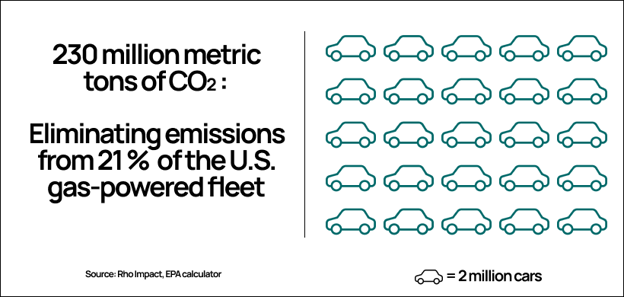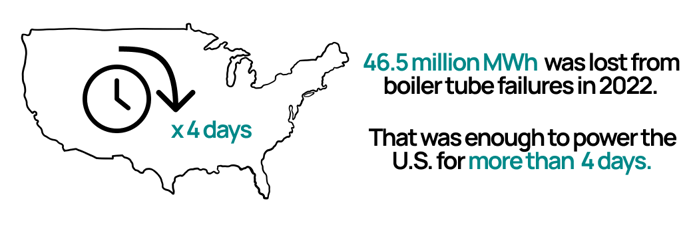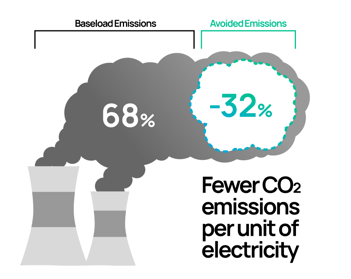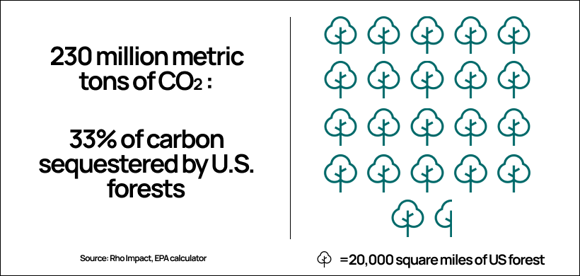Enabling today’s industrial facilities to improve their availability, reliability, and sustainability is an important part of improving environmental impact, and is a vital bridge to the net-zero future we’re all working toward. Gecko’s customers are currently leveraging software that’s powered by first-order data to unlock incredible results for environmental impact – eliminating leaks, increasing equipment efficiency and reliability, and operating their equipment smarter.
A new report published by Rho Impact, an analytics firm specializing in emerging climate technologies, explores the environmental impact potential of deploying robotics and AI at scale against a single problem in the power industry: the failure of boiler tubes.
The results were surprising. Rho Impact found that if we eliminate failures from this single piece of equipment inside power plants by pairing robotic inspections with AI-powered software, we could reduce carbon dioxide (CO2) emissions worldwide by as much as 230 million metric tons (MMT) – which is equivalent to as much as 4.8% of projected U.S. emissions.
Reducing emissions by 230 MMT is equivalent to removing about 51 million gas-powered cars from the roads which represents roughly 21% of the current U.S. fleet of gasoline-powered light-duty vehicles, like passenger cars, pickup trucks, and vans.

Boiler Tube Failures Lead to Backup Power Generation
Let’s start with the big picture. Coal and natural gas generate 63% of global electricity. 46.5 million MWh of electricity generation was lost in 2022 in the U.S. alone due to boiler tube failures. 46.5 million MWh is enough energy to power the entire United States for more than four days or NYC for more than seven months. With energy demand at an all-time high, what happens when boiler tube failures force power plants offline? How is this lost electricity replaced?
 When boiler tubes fail, the plant shuts down and backup power generation is often turned on to meet energy demands, especially during peak periods. In the U.S., peaker plants are a common form of backup power generation.
When boiler tubes fail, the plant shuts down and backup power generation is often turned on to meet energy demands, especially during peak periods. In the U.S., peaker plants are a common form of backup power generation.

The problem? Backup generation is less efficient and leads to higher CO2 emissions per unit of energy generated. Rho Impact’s research showed that power generated on baseload can be up to 32% more efficient than the same amount of power generated by peaker plants.
CO2 emissions don’t just contribute to climate change. They also have an immediate impact on nearby communities, degrading air quality and contributing to negative health outcomes for residents. Apart from these harmful emissions, plant failures also make the overall plant less efficient and put workers at risk as they rush to make repairs to get critical plant assets back into operation.
Robots and AI Reduce Plant Failures by Enabling Precision Repairs
According to the Rho Impact report, deploying robotic inspections and AI-powered predictive maintenance software reduces plant failures – and, by extension, reduces CO2 emissions.
Our experience in the field is that advances in robotics and AI have resulted in Gecko’s ability to eliminate boiler tube failures, a major cause of forced outages. According to the North American Reliability Corporation, boiler tube leaks cause nearly 24% of all forced outages at coal power plants and 4% at natural gas plants (weighted by lost megawatt hours of electricity production). Industries like the energy sector still largely rely on manual inspections that produce sparse data that is often locked inside a filing cabinet.
Alternatively, Gecko’s robots are equipped with advanced sensor technology that perform full-health scan inspections on boiler tubes, collecting high-fidelity data from hazardous, hard-to-access areas. The robots acquire millions of ultrasonic data readings.
The high-density data layers are processed and analyzed through an AI-powered software platform to identify areas of corrosion, degradation, cracking, and other damage that could lead to critical failure. Our software provides predictive analytics to inform plant engineers of high-risk damage, empowering them to make repairs before failures occur. When failures are eliminated, power plants don’t need to turn on less efficient and dirtier backup generation methods.
The result is a significant decrease in CO2 emissions. According to the Rho Impact study, if robotic inspections and predictive maintenance software were implemented across all fossil fuel power plants in the world, CO2 emissions could decrease by 52 - 230 MMT annually.
230 MMT is also the amount of CO2 absorbed by nearly 428,500 square miles of forested land in the U.S. – or one-third of all U.S. forests.

Alternatively, 230 MMT is equivalent to 4.8% of all CO2 emissions from the U.S. in 2022. According to the Rho Impact report, if the midpoint of emissions savings is realized year after year, robotic inspections can avoid a cumulative total of 788 MMT CO2 by 2030 and 3,050 MMT CO2 by 2050.
Eliminating Aging Infrastructure Is Not Possible -- We Must Improve It
The world’s aging critical infrastructure that provides power, water, transportation, national security, etc. produces carbon emissions. However, few consider that we can reduce these emissions by improving how we operate and maintain that infrastructure. Many jump to fully replacing and electrifying infrastructure versus enhancing the reliability and sustainability of existing infrastructure.
While the net-zero world is coming, it’s still decades away. As we make strides to get there, ensuring the reliable operation of our current infrastructure advances our climate goals. The Rho Impact study shows how this is the case for fossil fuel power plants.
Where Can Robots and AI Go From Here?
Within power generation, boiler tubes are just one component in a highly connected system of assets. Boiler tube failures bring energy production to a grinding halt. If applying robotic inspections and AI-powered software to boiler tubes can potentially reduce CO2 emissions by as much as 230 MMT, what is the impact of inspecting other failure-prone assets at power plants and across other hard-to-abate industries, like manufacturing, logistics, maritime, and oil & gas?
As we continue to build better robots and sensors and train ever-more accurate AI models on larger data sets, what new efficiencies might we uncover? Preventing failures is only one slice of the opportunities to improve our built world.
We envision a future where digital models empower industry leaders to optimize how they operate assets, scaling those optimizations across entire enterprises. At Gecko, we’re finding new, efficient ways to improve operations and sustainability performance across industries. See how by checking out our case studies.
Supporting Current Infrastructure Supports Climate Goals
The study presents some exciting possibilities. More importantly, its results validate that investing in the physical environment can improve both reliability and sustainability, reducing carbon emissions in sectors where our aging infrastructure is failing.
Until the net-zero infrastructure of the future is built, we are continuing to find ways to enhance the resilience and sustainability of our existing infrastructure.
